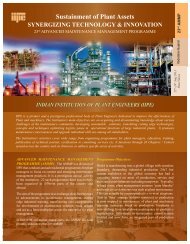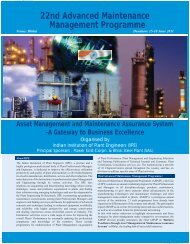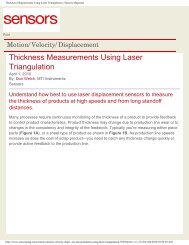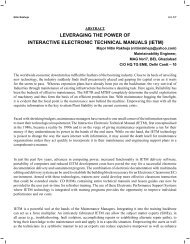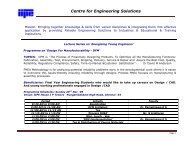how to increase heat transfer and reduce waterwall tube ... - IIPE
how to increase heat transfer and reduce waterwall tube ... - IIPE
how to increase heat transfer and reduce waterwall tube ... - IIPE
Create successful ePaper yourself
Turn your PDF publications into a flip-book with our unique Google optimized e-Paper software.
Pradeep Jain 3.1- 1/17<br />
HOW TO INCREASE HEAT TRANSFER AND REDUCE WATERWALL<br />
TUBE FAILURE IN HIGH PRESSURE BOILERS<br />
Dr. Pradeep Jain -DGM, NETRA- R&D, NTPC Limited,<br />
ABSTRACT:<br />
In spite of maintaining the very good water chemistry in water / steam cycle of thermal power plant,<br />
corrosion phenomena takes place in the boilers. The product of corrosion in the feed water system<br />
transported in<strong>to</strong> the boiler <strong>and</strong> gets deposited on the internal surface of <strong>waterwall</strong> <strong>tube</strong>s. It leads <strong>to</strong><br />
over<strong>heat</strong>ing <strong>and</strong> On-load corrosion <strong>and</strong> ultimately <strong>tube</strong> failure. To achieve the almost zero <strong>tube</strong> failure<br />
in <strong>waterwall</strong> of high pressure boilers, post-operational chemical cleaning is essential at the frequent<br />
intervals in the life span of power plant which will improve <strong>heat</strong> <strong>transfer</strong> <strong>and</strong> <strong>reduce</strong> under deposit onload<br />
corrosion. This paper will discuss the phenomena of localised corrosion, its remedial measures <strong>to</strong><br />
achieve near zero <strong>tube</strong> failure.<br />
INTRODUCTION<br />
The NTPC Limited has more than 125 numbers of fossils fi red, sub critical, high pressure boilers ranging<br />
from 100 <strong>to</strong> 190 kg/cm 2 . The saturation temperature of boiler water varies from 250 – 370 ºC depending<br />
upon the boiler pressure. The capacity of these boilers varies from 60 MW <strong>to</strong> 500 MW, whereas the<br />
<strong>heat</strong> fl ux varies from 200-300 KW/m 2 . These boilers are generally drum type <strong>and</strong> a few once through<br />
types. Waterwall <strong>tube</strong>s of these boilers are made of carbon steel or low alloy steel. Dematerialized<br />
water is used in these boilers with proper boiler water treatment generally recommended by Original<br />
Equipment Manufacturer (OEM). Generally Non volatile treatment (NVT) i.e. TSP is used in most of the<br />
boiler <strong>to</strong> maintain the pH except a few boilers where, all volatile treatment (AVT) chemicals is used. Due<br />
<strong>to</strong> On-load corrosion in low pressure parts, condenser <strong>and</strong> <strong>heat</strong> exchangers of boilers, deposition of<br />
corrosion products <strong>and</strong> salt concentration takes place on the internal surface of <strong>waterwall</strong> <strong>tube</strong>s. Ingress<br />
of raw water due <strong>to</strong> condenser leaks in<strong>to</strong> the feed water also <strong>increase</strong>s the salt deposition <strong>and</strong> oxygen<br />
concentration on internal surface due <strong>to</strong> boiling. The condenser of 500 MW genera<strong>to</strong>rs can contain<br />
300 miles of tubing <strong>and</strong> approx. 50000 <strong>tube</strong>-<strong>to</strong>-<strong>tube</strong>-plate joints, so some in-leakage of the external<br />
cooling water is inevitable from time <strong>to</strong> time. Thermal conductivity of this deposit is very low (about 2<br />
W/m/ºC) in comparison of carbon steel (about 50 W/mºC), thus signifi cantly <strong>reduce</strong>s the <strong>heat</strong> <strong>transfer</strong><br />
<strong>and</strong> <strong>increase</strong>s the outer metal temperature. Frequent <strong>tube</strong> failure has been observed in old boilers<br />
ran more than 100,000 hours due <strong>to</strong> internal localised corrosion. Tube failure investigation indicated<br />
that the main reason of <strong>waterwall</strong> <strong>tube</strong> failure is either due <strong>to</strong> hydrogen damage or caustic corrosion or<br />
over<strong>heat</strong>ing or the effect of all. Some of the case his<strong>to</strong>ries experienced in different capacities boilers<br />
of State Electricity Boards as well as NTPC Ltd. along with their remedial measures <strong>to</strong> attain zero <strong>tube</strong>
Pradeep Jain 3.1- 2/17<br />
failure have been discussed in this paper.<br />
How mild steel corrodes in boiler water<br />
Waterwall <strong>tube</strong>s in most of the fossil-fi red boiler are made of carbon steel. In pure DM water, or in very<br />
dilute acid or alkaline solutions at boiler temperature, it normally corrodes very slowly <strong>to</strong> form the black<br />
iron oxide known as magnetite (Fe 3<br />
O 4<br />
). The overall reaction is:<br />
3 Fe + 4 H 2<br />
O -------à Fe 3<br />
O 4<br />
+ 4 H 2<br />
The corrosion rate is dependent by the rate at which the reactant (water) can reach the metal surface<br />
<strong>and</strong> the reaction product can leave the surface. In nearly neutral solutions, magnetite is very slightly<br />
soluble <strong>and</strong> it deposits as coherent <strong>and</strong> tenacious surface fi lm, which greatly impedes this two-way<br />
chemical traffi c. The transport processes are dominated by slow state diffusion through the oxide<br />
layer <strong>and</strong> the corrosion rate is virtually independent of solution composition. The corrosion rate is also<br />
diminishes with time as the oxide thickness grows. Even after years of exposure, the layer is no more<br />
than a few microns thick.<br />
In more alkaline or more acid solutions, magnetite becomes increasingly soluble <strong>and</strong> precipitates in<br />
a different physical form. Instead of yielding a strongly coherent fi lm, it has a more porous structure.<br />
Soluble species can now diffuse relatively rapidly through the fi lm <strong>and</strong> the corrosion rate is much<br />
faster, although it still falls off the time as the oxide accumulated. The deposition of salts <strong>and</strong> corrosion<br />
products observed in different <strong>waterwall</strong> <strong>tube</strong>s has s<strong>how</strong>n in the pho<strong>to</strong>graph no.1-4.<br />
Pho<strong>to</strong>graph no.1 & 2 s<strong>how</strong>ing <strong>waterwall</strong> <strong>tube</strong>s of 60 MW boilers having a very thick deposit ranging
Pradeep Jain 3.1- 3/17<br />
thickness 1.0-1.5 mm.<br />
Pho<strong>to</strong>graph no. 3 & 4 s<strong>how</strong>ing a <strong>waterwall</strong> <strong>tube</strong> of 200 & 110 MW boilers having a thick iron oxide as<br />
well as hardness salt deposition which is non uniform in nature.<br />
Regions of Heat Transfer in Boilers<br />
Both recirculating drum type boilers <strong>and</strong> once-through boilers are in use in NTPC. Drum type boiler<br />
consists of three separate components: an evapora<strong>to</strong>r (<strong>waterwall</strong> area), where water is converted <strong>to</strong> a<br />
steam-water mixture: a drum, in which two phases are separated <strong>and</strong> a super <strong>heat</strong>er. A once-through<br />
boiler, on the other h<strong>and</strong>, is a single unit with sub-cooled (below the boiling point at that pressure) water<br />
entering at one end <strong>and</strong> super<strong>heat</strong>ed steam leaving at the other end. Because of its lower capital cost,<br />
the once-through type is becoming more popular <strong>and</strong> now NTPC is going for 660 MW super critical<br />
once-through boilers.<br />
The various regions of <strong>heat</strong> <strong>transfer</strong> in a once-through boiler <strong>tube</strong>, with uniform <strong>heat</strong> fl ux, are s<strong>how</strong>n in<br />
Figure-1.
Pradeep Jain 3.1- 4/17<br />
Figure-1 S<strong>how</strong>ing water-steam formation in <strong>waterwall</strong> <strong>tube</strong>.<br />
Of the six different <strong>heat</strong> <strong>transfer</strong> regions, fi ve are usually present in a recirculation boiler (the exception<br />
is the dryout / post-dryout regions. dryout should not occur in recirculation boilers, but is possible if the<br />
fl ow in a <strong>tube</strong> is <strong>reduce</strong>d for any reason, or if one or more adjacent <strong>tube</strong>s are plugged).<br />
At the inlet, both wall <strong>and</strong> liquid are below saturation temperature <strong>and</strong> <strong>heat</strong>ing is by convection. At some<br />
point along the <strong>tube</strong>, the wall temperature exceeds the saturation temperature <strong>and</strong> bubbles are formed<br />
on the wall, although the bulk liquid temperature is below saturation. This is the region of sub-cooled<br />
nucleate boiling. (Continuing along the <strong>tube</strong>, the region of saturated nucleate boiling, where the bulk<br />
liquid temperature reaches saturation, is then enters).<br />
As more steam is formed, small bubbles coalesce <strong>to</strong> form large bubbles (slug fl ow). Eventually, these<br />
combine <strong>to</strong> give a central core of steam <strong>and</strong> leave an annular fl ow of water along the wall. Further<br />
along the <strong>tube</strong>, the liquid fi lm on the wall becomes sufficiently thin for convective <strong>heat</strong> <strong>transfer</strong> <strong>to</strong> the<br />
liquid surface coupled with direct evaporation <strong>to</strong> become the only means of <strong>heat</strong> <strong>transfer</strong>, because<br />
this method of <strong>heat</strong> <strong>transfer</strong> is highly effi cient, nucleation of bubbles at the wall ceases through lack of<br />
suffi cient super<strong>heat</strong>. At the same time, increasing steam velocity results in entrainment of liquid in the<br />
form of droplets. Depletion of the liquid fi lm by evaporation <strong>and</strong> droplet formation eventually results in<br />
complete dryout of the <strong>tube</strong> wall.<br />
A dramatic <strong>increase</strong> in wall temperature occurs at the dryout point. In the post-dryout region <strong>heat</strong>
Pradeep Jain 3.1- 5/17<br />
<strong>transfer</strong> is by convection in the steam phase, the droplets gradually disappearing by evaporation. At<br />
low <strong>heat</strong> fl uxes direct impingement of droplets on <strong>to</strong> the wall may also occur. Evaporation of all droplets<br />
fi nally produces single phase super<strong>heat</strong>ed conditions.<br />
WATER CHEMISTRY<br />
Impurities <strong>and</strong> additives present in water fed <strong>to</strong> high pressure boilers are controlled within closely<br />
defi ned limits for two very good reasons.<br />
(1) To <strong>reduce</strong> corrosion in the water-steam circuits <strong>to</strong> a minimum under normal <strong>and</strong> fault<br />
conditions<br />
(2) To <strong>reduce</strong> transport of iron oxide, hardness salts, silica etc. in<strong>to</strong> the boiler <strong>and</strong> turbine. These<br />
substances deposit out on the <strong>heat</strong> <strong>transfer</strong> surfaces <strong>and</strong> turbine blades.<br />
Accelerated corrosion in many regions of high pressure boilers is known <strong>to</strong> be brought about by<br />
concentration of corrosive substances (chlorides, sulphates, hydroxides <strong>and</strong> phosphates) by boiling.<br />
The main water chemistry regimes used <strong>to</strong> <strong>reduce</strong> corrosion <strong>and</strong> transport of iron oxide etc. <strong>to</strong> a minimum<br />
are given in Table below <strong>to</strong>gether with the advantages <strong>and</strong> disadvantages of each regime.<br />
Regime Dissolved Protective Advantages<br />
Disadvantages<br />
Oxygen level oxide<br />
on <strong>tube</strong><br />
surface<br />
All volatile<br />
treatment<br />
(0.5 ppm<br />
NH 3<br />
)<br />
Low
Pradeep Jain 3.1- 6/17<br />
in Table, very strict limits are specifi ed on the concentrations of many other substances. For example, in<br />
the case of a typical once-through boiler using all volatile treatment (AVT) water chemistry, upper limits<br />
for various substances under steady load conditions are as follows:<br />
Sodium 5 ppb Sulphate 2 ppb<br />
Chloride 2 ppb Silica 20 ppb<br />
N 2<br />
H 4<br />
1.5 X O 2<br />
(Min 10 ppb) Iron 5 ppb<br />
Cu + Ti 2 ppb<br />
CORROSION AND DEPOSITION IN VARIOUS HEAT TRANSFER REGIONS:<br />
Convective Heating region:<br />
In this region, at the inlet <strong>to</strong> a once through boiler, there have been no reported instances of <strong>tube</strong> failure<br />
owing <strong>to</strong> <strong>heat</strong> fl ux conditions. In the absence of boiling, the <strong>increase</strong> in corrosion rate should be small<br />
<strong>and</strong> related <strong>to</strong> the higher metal temperature <strong>and</strong> activation energy of the corrosion process in pure<br />
water. Studies on surfaces which have been oxidized under good water chemistry conditions s<strong>how</strong> that<br />
even at high <strong>heat</strong> fl uxes as high as 800 kW/m 2 , negligible amounts of sodium <strong>and</strong> chlorine are taken<br />
up from NaCl, NaOH, NaHSO 4<br />
, Na 2<br />
SO 4<br />
<strong>and</strong> Na 3<br />
PO 4<br />
solutions. Some iron is deposited from Fe (OH) 2<br />
,<br />
which is likely <strong>to</strong> be the initial form of iron produced by protective or aggressive corrosion under alkaline<br />
conditions.<br />
Nucleate boiling regions:<br />
Three types of situation are possible. Two of these are concerned with the formation of oxide deposits<br />
with different porosities on a <strong>tube</strong> surface <strong>and</strong> the effect of this on corrosion. In the fi rst instance, all<br />
oxide is assumed <strong>to</strong> deposit from iron dissolved in solution <strong>and</strong> <strong>to</strong> form an oxide layer of low porosity<br />
(50%). The situation in a real boiler may lie anywhere between these two<br />
extremes. The third situation is concerned with boiling at defects on a <strong>tube</strong> surface.<br />
Oxide deposit of high porosity:<br />
Oxide of high porosity (>50%) is found <strong>to</strong> deposit in drum as well as once-through boilers under both<br />
low <strong>and</strong> high oxygen water chemistry conditions. The deposition rate is approx. proportional <strong>to</strong> the<br />
concentration of particulate iron oxide <strong>and</strong> the square of the <strong>heat</strong> fl ux. The best approximation <strong>to</strong> the<br />
real situation is given by
Pradeep Jain 3.1- 7/17<br />
D = k q 2 c t<br />
Where, D = amount of magnetite deposited (kg/m2)<br />
q = the <strong>heat</strong> fl ux (W/m2)<br />
c = concentration of iron in water (kg/m3)<br />
t = time (hour)<br />
k = constant ( approx. 5 X 10-13 / W 2 m 2 /s<br />
In a wick boiling mechanism, salts dissolved in the boiler water can be concentrated by fac<strong>to</strong>rs > 10 4<br />
as s<strong>how</strong>n in the figure-2.<br />
Generally, the protective magnetite scale thickness is 10-15 microns in the <strong>waterwall</strong> <strong>tube</strong>. When the<br />
corrosion rate <strong>increase</strong>s due <strong>to</strong> upset of water chemistry parameters in boiler, (due <strong>to</strong> salt ingress <strong>and</strong><br />
concentration), the deposit formation also <strong>increase</strong>s due <strong>to</strong> corrosion of metal <strong>and</strong> precipitation of<br />
contaminants whose water solubility decreases at higher temperature on the evapora<strong>to</strong>r <strong>tube</strong> surface.<br />
To maintain the pH in boiler water, in case of reduction of pH due <strong>to</strong> salt ingress, addition of more<br />
Tri Sodium Phosphate (TSP) is required. In this process, at some places on the internal surface of<br />
<strong>waterwall</strong> <strong>tube</strong>s, deposit thickness <strong>increase</strong>s <strong>and</strong> the protective iron oxide scale becomes non protective<br />
<strong>and</strong> porous in nature. Porous, insulating types of deposits allow boiler water <strong>to</strong> diffuse in<strong>to</strong> the deposit<br />
where the water becomes trapped <strong>and</strong> boils.<br />
The boiling of deposit in entrapped water produces relatively pure steam which tends <strong>to</strong> diffuse out of<br />
the deposit, leaving behind super <strong>heat</strong>ed non-boiling equilibrium solution of caustic, which is responsible<br />
for caustic corrosion or acidic solution, which is responsible of hydrogen damage in <strong>waterwall</strong> <strong>tube</strong>s as<br />
discussed below.
Pradeep Jain 3.1- 8/17<br />
CAUSTIC CORROSION<br />
Figure-2 s<strong>how</strong>ing salt concentration under the deposit by Wick boiling phenomena<br />
If the salt concentrated under the deposit is having high pH due <strong>to</strong> concentration of caustic from TSP<br />
dosing, it start dissolution of protective magnetite (Fe 3<br />
O 4<br />
) layer on the evapora<strong>to</strong>r <strong>tube</strong> wall inner surface<br />
<strong>and</strong> form sodium ferrite (NaFeO 2<br />
) <strong>and</strong> sodium ferroate (Na 2<br />
FeO 2<br />
) as s<strong>how</strong>n in the equation.<br />
Fe 3<br />
O 4<br />
+ 4 NaOH -------à NaFeO 2<br />
+ Na 2<br />
FeO 2<br />
+ 2 H 2<br />
O<br />
Caustic corrosion has been s<strong>how</strong>n in the pho<strong>to</strong>graphs no.5 & 6. in <strong>waterwall</strong> <strong>tube</strong> of 200<br />
MW boilers.
Pradeep Jain 3.1- 9/17<br />
ACIDIC CORROSION<br />
Solution of low pH is generated in high pressure boilers in two different ways:<br />
1. pH of the entire boiler water is <strong>reduce</strong>d when contaminants which are acidic or becomes acidic<br />
when <strong>heat</strong>ed in <strong>to</strong> the boiler.<br />
2. The bulk boiler water remains alkaline but acidic solutions are generated within corrosion pits<br />
by the action of dissolved oxygen <strong>and</strong> chloride. The most common acid forming contaminant<br />
is sea water or a river water which is low in carbonate <strong>and</strong> sulphate. In the boiler, the acidity is<br />
<strong>increase</strong>d locally <strong>to</strong> corrosive concentrations by boiling.<br />
In the acidic or highly alkaline conditions, iron reacts <strong>and</strong> hydrogen is liberated.<br />
Fe + 2 NaOH = Na 2<br />
FeO 2<br />
+ H 2<br />
Fe + 2 HCl = FeCl 2<br />
+ H 2<br />
If the hydrogen is liberated in an a<strong>to</strong>mic form, it is capable of diffusing in<strong>to</strong> the steel. Some of this<br />
diffused, a<strong>to</strong>mic hydrogen will combine at metal grain boundaries or inclusions <strong>to</strong> produce molecular<br />
hydrogen, or it will react with iron carbides in the metal <strong>to</strong> produce methane.<br />
Fe 3<br />
C + 4 H = CH 4<br />
+ 3 Fe<br />
Because neither molecular hydrogen nor methane is capable of diffusing through the steel, these gases<br />
accumulate, primarily at grain boundaries. Eventually, the gas pressure created will cause separation<br />
of the metal at its grain boundaries, forming discontinuous, intergranular micro cracks as s<strong>how</strong>n in the<br />
micrograph-1.
Pradeep Jain 3.1- 10/17<br />
Micrograph-1 s<strong>how</strong>ing the fi ssures <strong>and</strong> cracks inside the metal due <strong>to</strong> hydrogen damage.<br />
As these micro cracks accumulate, <strong>tube</strong> strength diminishes until stresses imposed by the internal<br />
pressure exceed the tensile strength of the remaining, intact metal. At this point a thick-walled, longitudinal<br />
burst may occur depending on the extent of hydrogen damage as s<strong>how</strong>n in pho<strong>to</strong>graphs no. 7 & 8.<br />
Pho<strong>to</strong>graphs no. 7 & 8, Waterwall <strong>tube</strong>s s<strong>how</strong> the failure due <strong>to</strong> hydrogen damage due <strong>to</strong> localised<br />
acidic condition.<br />
EXPERIMENTAL PROCEDURE FOR DEPOSIT ASSESSMENT IN WATERWALL<br />
TUBE<br />
Boiler <strong>tube</strong> sampling:<br />
Four <strong>waterwall</strong> <strong>tube</strong>s are cut from the four corner / sides of the high <strong>heat</strong> fl ux zone of the boilers, i.e.<br />
mainly from the uppermost portion of (2-3 meters above) burner zone. The <strong>tube</strong> sample are prepared<br />
as per ASTM D-3483, machined <strong>and</strong> cut longitudinally in two parts, one being the hot side (internal<br />
surfaces facing fi re side) <strong>and</strong> the other, the cold side (internal surfaces facing remote side). Internal<br />
deposition from the samples is removed for chemical analysis mechanically by pressing the machined<br />
sample in a vice. The average quantity of internal deposits is calculated separately for both the sides<br />
from the difference between sample <strong>tube</strong> weights, measured before <strong>and</strong> after the deposits are removed<br />
chemically.
Pradeep Jain 3.1- 11/17<br />
Deposit quantity assessment:<br />
Waterwall <strong>tube</strong> samples are collected from site <strong>and</strong> machined on the outer surface. The outer machined<br />
surface of the <strong>tube</strong> is painted with corrosion resistant lacquer. The internal surface area (A, in cm 2 )<br />
is measured <strong>and</strong> the initial weight (W 1<br />
, in mg) of the <strong>tube</strong> samples is measured. The <strong>waterwall</strong> <strong>tube</strong><br />
sample is cleaned in 5% inhibited hydrochloric acid solvent at 65 ºC <strong>and</strong> put on a magnetic stirrer till the<br />
deposit is removed completely from the internal surfaces. Then it is washed with demineralised water<br />
<strong>and</strong> an alkaline solution <strong>and</strong> dipped in a surface passivation solution for 5-10 minutes. The fi nal weight<br />
of the sample (W 2<br />
, in mg) is measured. The quantity of internal deposit (DQ, in mg.cm 2 ) is calculated<br />
by the following formula.<br />
W 1<br />
– W 2<br />
DQ = ---------------<br />
A<br />
CRITARIA FOR CHEMICAL CLEANING<br />
Chemical cleaning of a boiler is suggested on the basis of the quantity of intenal deposit present in the<br />
<strong>waterwall</strong> <strong>tube</strong>s of the boiler. When the quantity of deposit exceeds 40 mg/cm2, the <strong>tube</strong> surfaces are<br />
considered <strong>to</strong> be very dirty surfaces as per the Indian St<strong>and</strong>ard 10391-1998 <strong>and</strong> the chemical cleaning<br />
is suggested <strong>to</strong> improve the <strong>heat</strong> <strong>transfer</strong> <strong>and</strong> <strong>reduce</strong> the over<strong>heat</strong>ing. The guidelines are given in<br />
Table-1.<br />
Table-1 s<strong>how</strong>ing limits of deposit quantity allowed in <strong>waterwall</strong> <strong>tube</strong>s at different pressure.<br />
The deposit quantity measured in high pressure boilers of different site are given here along with the<br />
trend chart <strong>and</strong> recommendations for chemical cleaning.
Pradeep Jain 3.1- 12/17<br />
A List of NTPC boilers in which chemical cleaning carried out under the<br />
supervision of NTPC (R&D)<br />
1. Ramagundam, Boiler # 1, 200 MW Oct. 1998<br />
2. Ramagundam, Boiler # 2, 200 MW Sept. 1999<br />
3. Ramagundam, Boiler # 3, 200 MW July 2000<br />
4. T<strong>and</strong>a, Boiler # 1, 110 MW June 2000<br />
5. T<strong>and</strong>a, Boiler # 2, 110 MW Feb. 2002<br />
6. T<strong>and</strong>a, Boiler # 3, 110 MW Jan. 2001<br />
7. T<strong>and</strong>a, Boiler # 4, 110 MW Aug. 2002<br />
8. Talcher Thermal, Boiler # 1, 60 MW Dec. 1995<br />
9. Talcher Thermal, Boiler # 2, 60 MW Feb. 1996<br />
10. Talcher Thermal, Boiler # 3, 60 MW June 2002<br />
11. Talcher Thermal, Boiler # 4, 60 MW May 2000<br />
12. Badarpur, Boiler, #1 95 MW Dec. 2006<br />
13. Badarpur, Boiler # 3 95 MW Oct. 2004<br />
14. Badarpur, Boiler # 2 95 MW Nov. 2004<br />
15. Badarpur, Boiler #4 210 MW Aug. 2006<br />
16. Korba, Boiler #1 200 MW Oct. 2007<br />
17. Singrauli, Boiler #3 200 MW April 2008<br />
18 . T<strong>and</strong>a, Boiler # 3, 110 MW May 2008<br />
19. Vindhyachal, Boiler # 1, 210 MW May 2008<br />
20. Farakka, Boiler #3 200 MW July 2008<br />
21. Ramagundam, Boiler #3 200 MW Aug. 2008<br />
22. Unchhahar, Boiler #1 210 MW Aug. 2008<br />
23. Rih<strong>and</strong>, Boiler #1 500 MW Sept. 2008<br />
24. Ramagundam, Boiler #1 200 MW Sept. 2008<br />
25. Vindhyachal, Boiler # 2 210 MW Oct. 2008<br />
26. Vindhyachal, Boiler # 4 210 MW May 2009<br />
27. Kahalgaon, Boiler # 4 210 MW May 2009<br />
28. Farakka, Boiler # 2 200 MW May 2009<br />
CONCLUSIONS<br />
Failure investigation studies of <strong>waterwall</strong> <strong>tube</strong>s of different capacity boilers indicated the reasons of<br />
<strong>tube</strong> failure are:
Pradeep Jain 3.1- 13/17<br />
Formation of localised alkaline / acidic conditions is as per the mechanism of wick boiling phenomena<br />
under the deposit due <strong>to</strong> ingress of raw water in<strong>to</strong> the condensate water. Acidic localised condition is<br />
responsible for hydrogen damage as observed in many old boilers where the deposit is very high <strong>and</strong><br />
adherent type. Alkaline condition is responsible for caustic corrosion where the deposit is dense <strong>and</strong><br />
porous in nature.<br />
Over<strong>heat</strong>ing of <strong>tube</strong>s due <strong>to</strong> deposition of salts on the internal surface of <strong>tube</strong>.<br />
REMEDIAL MEASURES<br />
It is suggested, <strong>to</strong> control the ingress of cooling water from the condenser <strong>tube</strong> leakage which will<br />
<strong>reduce</strong> the phenomena of salt concentration on the internal surface of boiler <strong>tube</strong>s.<br />
If the internal oxide growth <strong>increase</strong>s from the limit as per the Indian St<strong>and</strong>ards of IS-10391-98. Post<br />
– operational chemical cleaning of boilers should be carried out <strong>to</strong> remove the existing porous deposit<br />
<strong>and</strong> <strong>to</strong> form a new adherent magnetite layer. Magnetite layer will work as a protective layer <strong>and</strong> <strong>reduce</strong><br />
the possibilities of on-load corrosion.<br />
ACKNOWLEDGEMENT<br />
Authors are thankful <strong>to</strong> Shri Sharad An<strong>and</strong>, E.D., NETRA, Shri A.K.Mohindru G.M. (NETRA-R&D)<br />
<strong>and</strong> Shri J. Rajendran AGM (NETRA-R&D) for his continued interest, valuable guidance <strong>and</strong> constant<br />
encouragement for chemical cleaning of boilers. The contributions of our colleagues of NTPC sites<br />
<strong>and</strong> NETRA, who have helped directly or indirectly for carryout the chemical cleaning, are greatly<br />
acknowledged.<br />
REFERENCES<br />
1. Test methods for accumulated deposition in a steam genera<strong>to</strong>r <strong>tube</strong>, 2005, ASTM International,<br />
West Conshohocken, PA, USA, ASTM St<strong>and</strong>ard D-3483-05.<br />
2. Code of practice for chemical cleaning of boilers, 1998, Bureau of Indian St<strong>and</strong>ards, New<br />
Delhi, IS-10391-98.<br />
3. Sugimo<strong>to</strong> A, Ueki, H. Sakuma, S., Proc. American Power Conference, 1972. Illinois institute of<br />
Technology, Chicago, IL, USA, 34, 764
Pradeep Jain 3.1- 14/17<br />
4. David E. Hendrik, Hydrogen attack on <strong>waterwall</strong> <strong>tube</strong>s in a high pressure boiler, Material<br />
Performance, Aug. 1995, pp-46-51.<br />
5. C. Syrett, Corrosion in fossils fuel power plant, EPRI, USA<br />
6. L. Tomlinson <strong>and</strong> A.M. Pritchard, Effects of <strong>heat</strong> fl ux on corrosion of high pressure boilers, Br.<br />
corrosion J., 1985, vol.20, No.4, pp-187-195.<br />
7. R.D. Port, Identifi cation of corrosion damage in boilers, Material Performance, Dec. 1994, pp<br />
– 45-51.<br />
8. G.M.W. Mann, His<strong>to</strong>ry <strong>and</strong> causes of On-load water side corrosion in power plants, Br.<br />
Corrosion J., 1977, vol. 12 No.1, pp – 7-14.<br />
ABOUT THE AUTHOR<br />
Dr. Pradeep Jain, M.Sc., MBA, Ph.D. (Chemistry)<br />
4 years experience in O&M, Water Chemistry at Thermal Power plants, Satpura <strong>and</strong> Korba<br />
(MPEB) from 1982-86.<br />
Joined NTPC (R&D) in 1986 <strong>and</strong> having 23 years of work experience at in the field of water<br />
chemistry <strong>and</strong> corrosion studies in High pressure Boilers, Turbines <strong>and</strong> Genera<strong>to</strong>rs of power<br />
plants.<br />
Specialized in the field of Post-operational chemical cleaning of high-pressure boilers <strong>and</strong><br />
condensers.<br />
Carried out solvent selection studies <strong>and</strong> supervised post-operational chemical cleaning of 35<br />
nos. of NTPC <strong>and</strong> 06 numbers of State Electricity Boilers <strong>and</strong> improve the <strong>heat</strong> <strong>transfer</strong> efficiency<br />
<strong>and</strong> <strong>heat</strong> rate in the range of 20-30 Kcal/kwh.
Pradeep Jain 3.1- 15/17<br />
Recently, he has visited <strong>to</strong> Fujairah water <strong>and</strong> power plant, UAE <strong>to</strong> find out the Root cause<br />
Failure in evapora<strong>to</strong>r <strong>tube</strong>s in HRSG’s. It is an international consultancy work through NTPC<br />
- International consultancy group.<br />
Working in the field of void fraction measurement <strong>and</strong> thermal moni<strong>to</strong>ring in <strong>waterwall</strong> <strong>tube</strong>s <strong>to</strong><br />
measure the <strong>heat</strong> flux, internal deposit <strong>and</strong> steam water ratio.<br />
Published research papers in national <strong>and</strong> international journals <strong>and</strong> file two patents for void<br />
fraction measurement techniques.<br />
Presently working as Deputy General Manager, NETRA-R&D<br />
Supporting Tables:<br />
Table-2, Badarpur unit no. 1 was chemically cleaned once in Dec. 2006
Pradeep Jain 3.1- 16/17<br />
Table-3, Badarpur unit no. 2 was chemically cleaned once in Nov. 2004<br />
Table-4, Badarpur unit no. 3 was chemically cleaned once in Oct.. 2004
Pradeep Jain 3.1- 17/17<br />
Table-5, Badarpur unit no. 4 was chemically cleaned once in Aug. 2006<br />
Table-6, Badarpur unit no. 5, two stage chemical cleaning recommended in Dec. 2005



